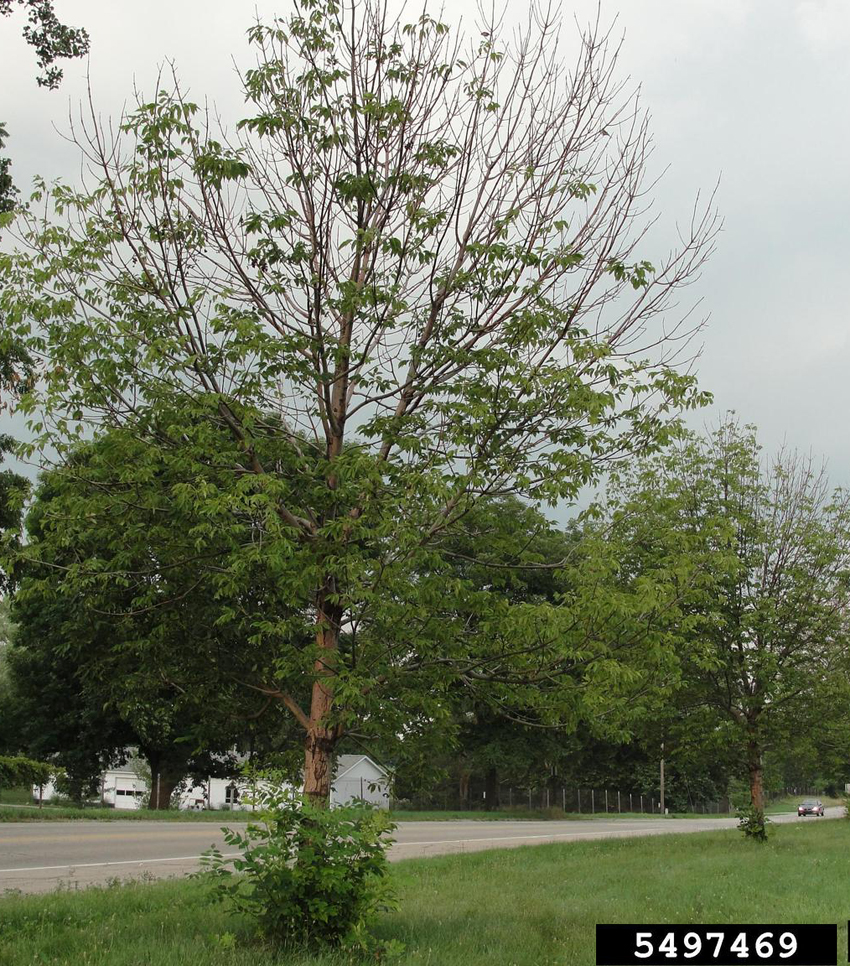
Dying roadside ash trees in another state. Ash trees are recognized by their opposite branching pattern and compound leaves. Photo by Leah Bauer. Bugwood.org
If you’re a Texan and haven’t heard about an insect called the emerald ash borer, that’s about to change. The emerald ash borer (EAB) is an invasive beetle that feeds almost exclusively on ash (Fraxinus spp.) and has been slowly spreading through the eastern and midwest states from Michigan where it was first discovered in 2002.
On May 23 the Texas Forest Service, along with the U.S. Forest Service, announced that four EAB beetles had been discovered on a trap in Harrison County, TX along the Louisiana border. Although no infested trees have yet been discovered in Texas, these beetles signal a perhaps inevitable change in fortune all for Texas ash trees.
Last summer I visited Indiana where EAB has been active for several years. The destruction was sobering. Dead trees along highways, in parks, and in yards. In fact you would be hard pressed in Indianapolis or Lafayette, where I visited, to find a single healthy ash unless it had been treated with a protective insecticide.
Emerald ash borer affected trees typically die two or three years after becoming infested. Native to Asia, nothing seems to be stopping the EAB, short of continual insecticide protection. The beetles have killed tens of millions of ash trees throughout the U.S., and currently 26 states are under quarantine restrictions for shipping of ash wood.
In the United States, 16 ash species are susceptible, and Texas is home to seven. According to TFS, ash trees make up less than 5 percent of rural Texas forests but are a larger portion of urban street and park trees. Texas A&M Forest Service is currently working with APHIS, the Texas Department of Agriculture, Texas A&M AgriLife Extension and the U.S. Forest Service, among other state and federal agencies, to implement a state response plan.
In a web conference this morning, state and federal officials sought to reassure the Texas timber industry that, at least initially, any impacts to forest products industry should be low. The TFS has established a new website where Texans can follow the progression of any invasion, and learn what steps that can be taken to protect your personal ash trees.
If you have an ash in your backyard there is little immediate threat unless you live in Harrison county, or an immediately adjacent county. Experience with EAB in other parts of the country suggests that there is no need to treat your ash tree unless your home is within 10-15 miles of a known infestation, and that still has not occurred anywhere in Texas.
For more information about how to spot EAB damage see my earlier post at http://citybugs.tamu.edu/2015/10/23/recognizing-emerald-ash-borer-damage/
And, by the way, if you’re looking for a nice shade tree to accommodate you in your retirement years, and you live in Texas, I wouldn’t choose any kind of ash.
